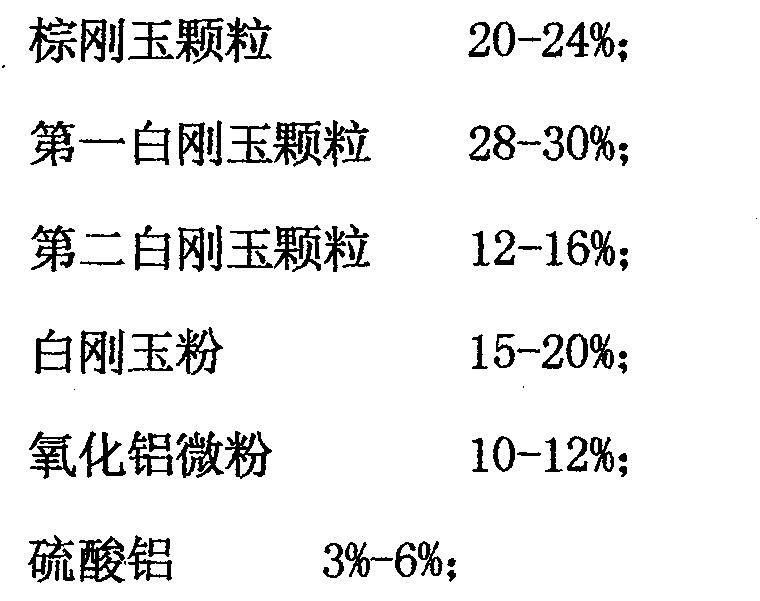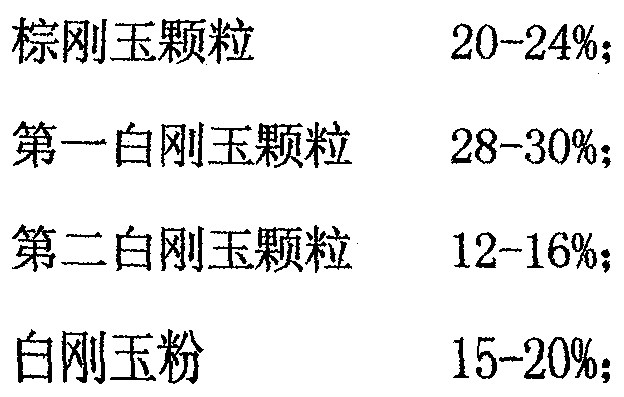Machine pressing carbon-free lining brick for steel ladles
A ladle and lining brick technology, which is applied in the field of machine-pressed carbon-free lining bricks for ladles, can solve the increasingly stringent requirements and cannot meet the smelting requirements of low-carbon steel and ultra-low carbon steel, etc., and achieve long service life and high thermal strength , the effect of high compressive strength
- Summary
- Abstract
- Description
- Claims
- Application Information
AI Technical Summary
Problems solved by technology
Method used
Image
Examples
Embodiment 1
[0014] In terms of weight percentage, mix 20% brown corundum particles, 28% first white corundum particles, and 12% second white corundum particles together and put them into a mixing mill, add 2% aluminum sulfate, and mix and grind for 5 Minutes, then add 10% alumina micropowder and 15% white corundum powder in turn, mix and grind for 5 minutes, then add 1% aluminum sulfate, carry out continuous mixing and milling for 12 minutes, then place it in the silo, and close it for 4 hours. Then use a 630-ton friction brick press to form. When forming, pour the carbon-free lining mud into the cavity of the brick machine. The material is evenly distributed. The first hammer is lightly hit, and the mold does not come out, because the brick has not yet been formed at this time, and the strength of the brick is low; At this time, hit the second hammer with a heavy hammer, and release the mold at the same time to exhaust the air; use the third hammer with a light hammer, because if you use ...
Embodiment 2
[0019] In terms of weight percentage, mix 21.5% of the brown corundum particles, 29% of the first white corundum particles, and 12.5% of the second white corundum particles together and put them into a mixing mill, add 3% of aluminum sulfate, and mix and grind for 5 Minutes, then add 10.5% alumina micropowder and 16.5% white corundum powder in turn, mix and grind for 5 minutes, then add 1.5% aluminum sulfate, carry out continuous mixing and grinding for 12 minutes, then place it in the silo, and close it for 4 hours. Then use a 630-ton friction brick press to shape it, and then seal it in an infrared drying kiln, dry it at 220° C. for 48 hours, and then cool it to room temperature. Other process conditions are the same as in Example 1.
[0020] 10 samples were randomly taken from the carbon-free lining bricks made in Example 2, and were tested for density, normal temperature compressive strength, 1500°C compressive strength and 1500°C linear change, and compared with existing...
Embodiment 3
[0024] In terms of weight percentage, mix 23% of the brown corundum particles, 30% of the first white corundum particles, and 15% of the second white corundum particles together and put them into a mixing mill, add 4% of aluminum sulfate, and mix and grind for 5 Minutes, then add 12% alumina micropowder and 18% white corundum powder in turn, mix and grind for 5 minutes, then add 2% aluminum sulfate, carry out continuous mixing and milling for 12 minutes, then place it in the silo, and close it for 4 hours. Then use a 630-ton friction brick press to shape it, and then seal it in an infrared drying kiln, dry it at 250° C. for 48 hours, and then cool it to room temperature. The other process conditions are the same as in Example 1.
[0025] 10 samples were randomly taken from the carbon-free lining bricks made in Example 3, and were tested for density, normal temperature compressive strength, 1500°C compressive strength and 1500°C linear change, and compared with existing magnesia...
PUM
| Property | Measurement | Unit |
|---|---|---|
| diameter | aaaaa | aaaaa |
| diameter | aaaaa | aaaaa |
| density | aaaaa | aaaaa |
Abstract
Description
Claims
Application Information
 Login to View More
Login to View More - R&D
- Intellectual Property
- Life Sciences
- Materials
- Tech Scout
- Unparalleled Data Quality
- Higher Quality Content
- 60% Fewer Hallucinations
Browse by: Latest US Patents, China's latest patents, Technical Efficacy Thesaurus, Application Domain, Technology Topic, Popular Technical Reports.
© 2025 PatSnap. All rights reserved.Legal|Privacy policy|Modern Slavery Act Transparency Statement|Sitemap|About US| Contact US: help@patsnap.com



